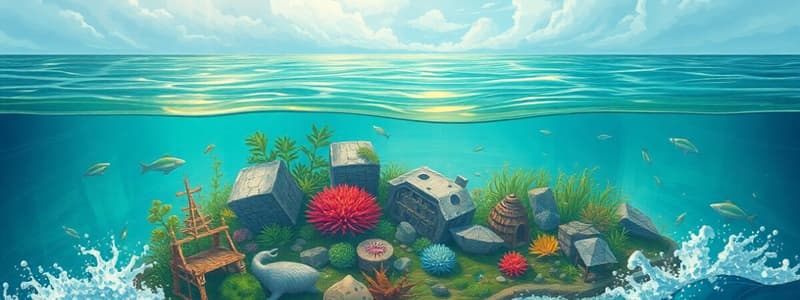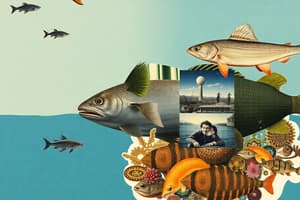Podcast
Questions and Answers
What percentage of Earth's surface is covered by the ocean?
What percentage of Earth's surface is covered by the ocean?
- 80%
- 50%
- 60%
- 70% (correct)
Which of the following best describes the ocean basins?
Which of the following best describes the ocean basins?
- They vary in size and are affected by plate tectonics. (correct)
- They are always flat and featureless.
- They consist only of coral reefs and sandy beaches.
- They are completely isolated from one another.
Which living organisms are identified as the most important primary producers in the ocean?
Which living organisms are identified as the most important primary producers in the ocean?
- Microbes (correct)
- Seaweeds
- Coral reefs
- Fish
What is the primary contribution of the ocean to the Earth's water cycle?
What is the primary contribution of the ocean to the Earth's water cycle?
What geological features can be found on the ocean floor?
What geological features can be found on the ocean floor?
What key role do phytoplankton play in the carbon cycle?
What key role do phytoplankton play in the carbon cycle?
How does the ocean influence the Earth's climate?
How does the ocean influence the Earth's climate?
What happens when the ocean becomes acidic?
What happens when the ocean becomes acidic?
What factor contributes to variations in salinity in ocean water?
What factor contributes to variations in salinity in ocean water?
How can human activities impact ocean health?
How can human activities impact ocean health?
Flashcards
Earth's Ocean
Earth's Ocean
The single, interconnected body of water covering most of Earth's surface.
Ocean Basins
Ocean Basins
The distinct sections of the global ocean, like the Pacific or Atlantic.
Ocean Floor Features
Ocean Floor Features
The varied landscape under the sea, including ridges, trenches, and valleys.
Ocean's Role in Water Cycle
Ocean's Role in Water Cycle
Signup and view all the flashcards
Ocean Biodiversity
Ocean Biodiversity
Signup and view all the flashcards
Phytoplankton role in aquatic food web
Phytoplankton role in aquatic food web
Signup and view all the flashcards
Ocean's role in CO2 absorption
Ocean's role in CO2 absorption
Signup and view all the flashcards
Ocean-atmosphere heat exchange
Ocean-atmosphere heat exchange
Signup and view all the flashcards
Ocean acidification cause
Ocean acidification cause
Signup and view all the flashcards
Ocean's impact on human lives
Ocean's impact on human lives
Signup and view all the flashcards
Study Notes
Earth's Ocean: A Summary
-
Earth's ocean covers approximately 70% of the planet's surface, a defining feature.
-
The ocean is central to the water cycle, with evaporation returning as precipitation, vital for freshwater.
-
The ocean is a single interconnected system with various basins (North Pacific, South Pacific, North Atlantic, South Atlantic, Indian, Southern, Arctic).
-
Ocean basins are diverse, including seafloors with islands, deeps, ridges, trenches, rift valleys, and plateaus, shaped by plate tectonics.
-
The ocean floor is rich in lifeforms, impacting the marine ecosystems.
-
The ocean absorbs a significant portion of atmospheric CO2 and methane, playing a crucial role in the carbon cycle.
-
Phytoplankton, microscopic plants and bacteria, form the base of aquatic food webs. They consume CO2 and produce oxygen.
-
The ocean absorbs most solar radiation, moderating global temperatures and influencing weather patterns.
-
Ocean-atmosphere interactions result in weather phenomena like El Niño Southern Oscillation and La Niña, hurricanes and cyclones.
Ocean Water Properties and Composition
-
Ocean water is salty, with a slightly lower freezing point and higher density than freshwater.
-
Ocean water has high electrical conductivity and a slightly basic pH.
-
Ocean water is a buffer solution, maintaining pH balance critical for marine life and absorbing atmospheric CO2.
-
A change in ocean pH can impact CO2 absorption and potentially make the ocean a CO2 source.
-
Ocean water is a complex system of organic and inorganic substances, with salinity varying in different locations impacting currents.
The Ocean and Human Interdependence
-
The ocean affects all human lives—providing freshwater as rain, oxygen and moderating climate.
-
We rely on the ocean for food, medicine, resources, jobs, transportation, national security, inspiration, and recreation.
-
Human activities affect ocean health, causing pollution, ocean acidification, and physical modifications.
-
These human activities impact marine organisms, leading to coral bleaching and decreased biological diversity.
-
Coastal areas, home to much of the world's population, are vulnerable to natural hazards like tsunamis, hurricanes, and sea level changes.
Ocean Exploration and Understanding
-
Less than 15% of the ocean has been explored, leaving vast areas for discoveries.
-
Understanding ocean systems is vital for human survival.
-
Oceanography is an interdisciplinary field relying on biologists, chemists, climatologists, computer programmers, engineers, geologists, meteorologists, physicists, animators, and illustrators.
-
Exploration involves ships, research vessels, robots, subsea observatories, unmanned submersibles and satellites.
Studying That Suits You
Use AI to generate personalized quizzes and flashcards to suit your learning preferences.




